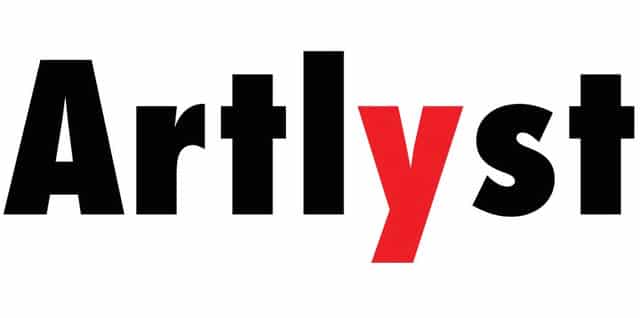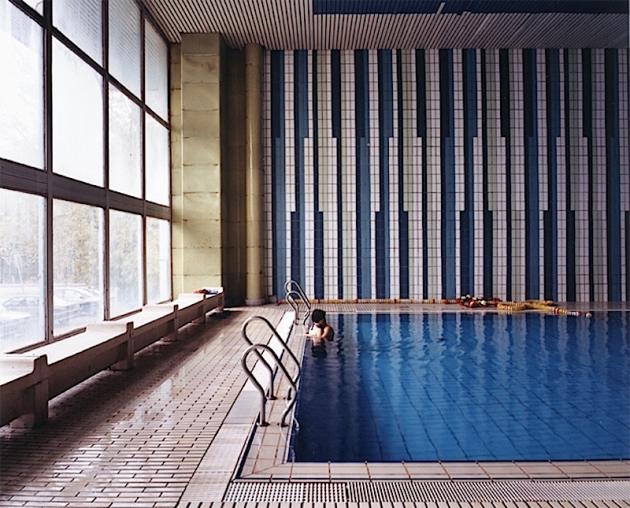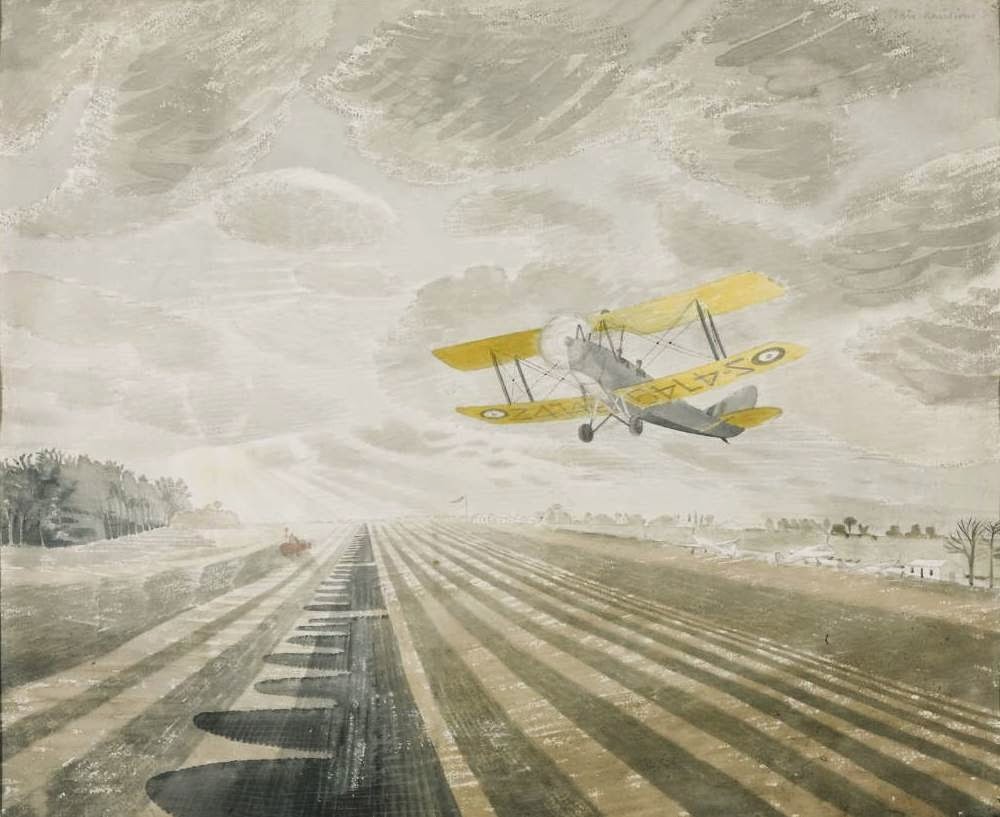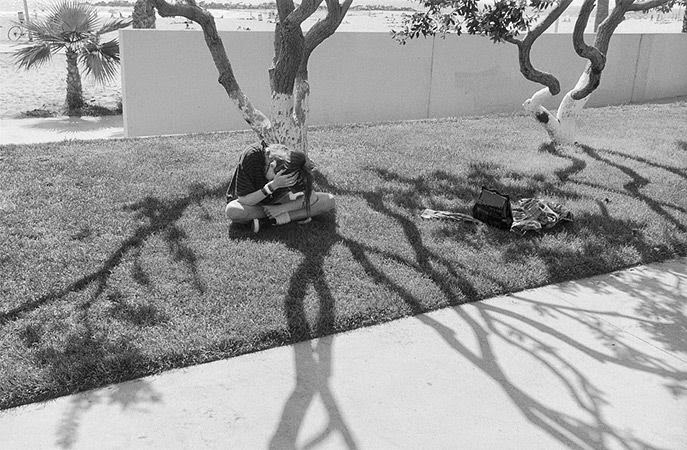Paul Carey-Kent one of London’s leading art critics give us his choices for summer art exhibitions not to miss.
‘Matthew Higgs and Clive Hodgson’ & ‘Figuratively’ @ Wilkinson, 50-58 Vyner St – Cambridge Heath
To 16 Aug: www.wilkinsongallery.com
This is quite the smorgasbord: New York mutli-tasker Matthew Higgs pairs his droll found text works, extended here from isolated phrases to the attachment of favourite books to the canvas, with the plangently diaristic abstract drollery of Clive Hodgson His nine paintings demonstrate, largely on a bigger scale than previously typical, that he’s far from running out of new ways to relish and subvert the combination of simple gesture, obtrusive signature and date. Higgs then mixes things up nicely by pairing that show, across both floors, with five figurative artists born in 1977-80. Of those I warmed most to Texan Daniel Rios Rodriguez’s small paintings encrusted with objects and wit, and Canadian Jane Corrigan’s slippery scenarios fluidly realised wet-into-wet: here her character seems to be preparing carrots for a rabbit she has killed with some sort of pastoral castration sub-plot going on.
___________________
Bruce Conner: Crossroads @ Thomas Dane Gallery, 11 Duke Street – St James’s
This may sound trite if not outright dull: a long film made in 1976 of atomic explosion tests from 1946, largely in slow motion, with some music. Yes, a terrible beauty… In practice. though, it’s compulsive viewing, partly due to the presentation on a 4 metre screen; partly due to the quality of the images taken from 328 high-tech cameras carried by drones and 64 aircraft, making the Bikini Atoll test the most photographed moment in history; partly due to the edit and pacing; and especially due to how that fits with 12 minutes of Patrick Gleeson’s re-creation on Moog of the sound of the explosion, followed by 25 minutes of Terry Riley’s organ improvisations, which take the troubled transcendental to a whole other level. Set aside 37 minutes now!
___________________
e-studio Luanda: African Industrial Revolution @ Tiwani Contemporary, 16 Little Portland StreetTo 15 Aug: www.tiwani.co.uk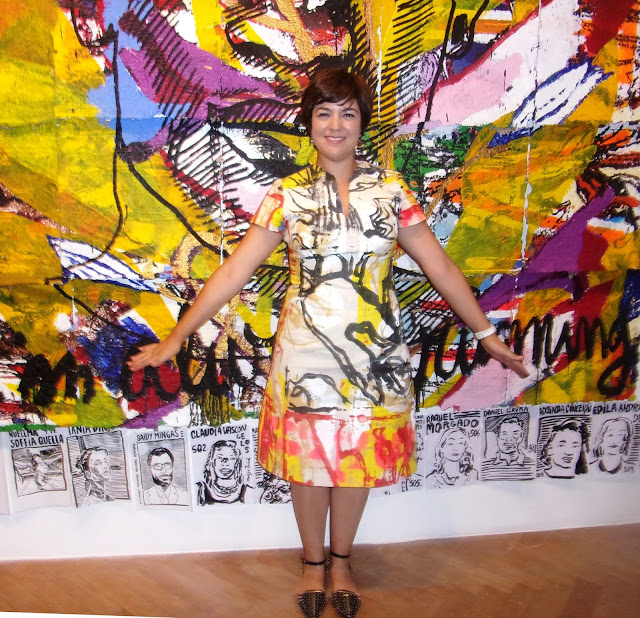 The show’s curator, Rita GT, has designed her clothes from Francisco Vidal’s paintings
The show’s curator, Rita GT, has designed her clothes from Francisco Vidal’s paintings
We’re getting some African weather, so why not check out this feelgood slice of Angola, actually a version of the national pavilion currently at Venice. That in itself reflects transportable nature of the concept: it’s an open studio set up by artists collective e-studio Luanda. The means of production are unpacked from the U.topia Machine, aka a plywood box on the floor. Painter Fancisco Vidal is holding the most prominent court, covering the walls with intensely colourful abstractly-patterned faces on handmade paper and rapidly sketching all-comers: my wall portrait was number 552. The idea, in a neat reversal, is to produce, distribute and share by traditional means a version of online experience.
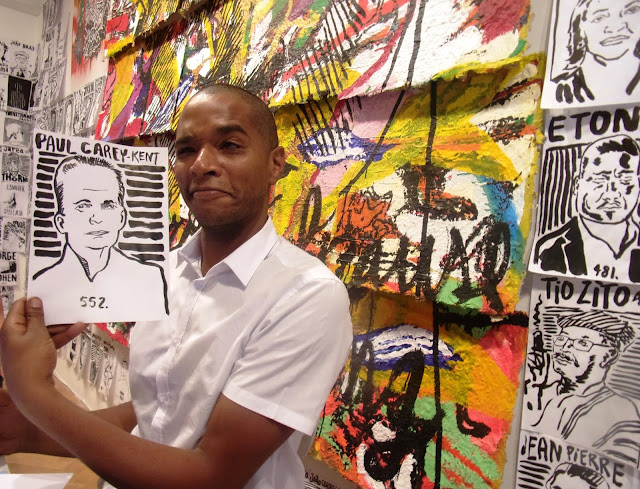 Francisco Vidal with one of his portrait drawings. I should add that they’re not meant to be realistic…
Francisco Vidal with one of his portrait drawings. I should add that they’re not meant to be realistic…
___________________
Emily Young: Call and Response: London @ The Fine Art Society, 148 New Bond St
To 29 Aug:
www.faslondon.com/fine_art_society_contemporary/exhibitions

Caramel Dark Face, 2015 Caramel Onyx – 23 x 16 x 19 cm
Emily Young, though born in London was partly raised in Rome and recently returned to live in Italy, where she works with the most traditional of means– free carving in the manner of Michelangelo. Yet there’s a 60s counterculture feel to how she sees her conversation with stone as being ‘small part of mankind’s most serious, most elemental conversation, that with Earth’. So it makes some sense that in her youthful days experimenting with drugs she was the Emily in Pink Floyd’s ‘See Emily Play’. Here, in the London half of a show shared with Venice, she shows an ability to release faces from a huge variety of minerals – typically discards from defunct quarries, which she prefers for their characterful imperfections.
 Verdite Forest Head, 2015Verdite 23 x 23 x 20 cm
Verdite Forest Head, 2015Verdite 23 x 23 x 20 cm
___________________
Tomoko Yoneda: Beyond Memory @ Grimaldi Gavin, 27 Albemarle Street – Mayfair
To 7 August: www.grimaldigavin.com
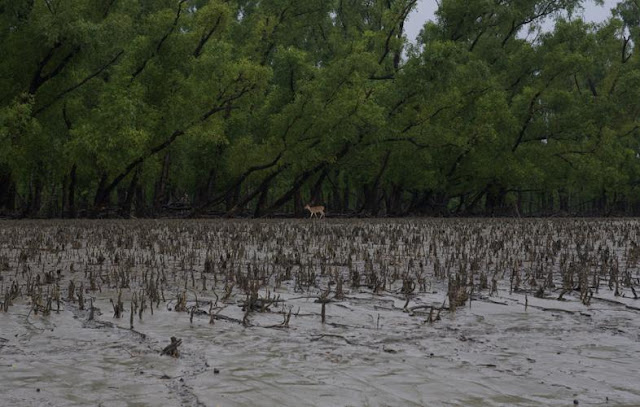 Lone Deer, Sanderbands, Bangldesh, 2008The London-based Japanese Tomoko Yaneda shows images from 2003 onwards to deal with the not infrequent trope of apparently innocuous photographs which turn out to be of sites freighted with historical and emotional resonance: a means, if you will, of magnifying the innate memorialising tendency of photography* . Among Yoneda’s subjects are homes built in the capital of Taiwan during a period of Japanese occupation (1895 to 1945); the most frequently flooded Delta in Bangladesh; and Stalin City in Hungary. Apart from being somewhat ahead of that curve, what distinguishes her treatment is the sheer poised allure of her pictures, which quietly raises the impact of the contradictions involved, and her ability to fix on some what TS Eliot might have called an objective correlative for the emotions felt, from a lone deer to peeling walls to a semi-submerged couple.
Lone Deer, Sanderbands, Bangldesh, 2008The London-based Japanese Tomoko Yaneda shows images from 2003 onwards to deal with the not infrequent trope of apparently innocuous photographs which turn out to be of sites freighted with historical and emotional resonance: a means, if you will, of magnifying the innate memorialising tendency of photography* . Among Yoneda’s subjects are homes built in the capital of Taiwan during a period of Japanese occupation (1895 to 1945); the most frequently flooded Delta in Bangladesh; and Stalin City in Hungary. Apart from being somewhat ahead of that curve, what distinguishes her treatment is the sheer poised allure of her pictures, which quietly raises the impact of the contradictions involved, and her ability to fix on some what TS Eliot might have called an objective correlative for the emotions felt, from a lone deer to peeling walls to a semi-submerged couple.
* Zarina Bhimji does something related in film, and I’d also commend her newest,Jangbar, at Nottingham New Art Exchange, 16 July – 27 Sept
Top PhotoLovers, Dunaújváros, Hungary , 2004
___________________
Isa Genzken: Basic Research Paintings & fig-2 26/50: Anne Hardy @ the ICATo 6 Sept (Genzken) / 5 July (Hardy)
 Isa Genzken, Basic Research, 1989, oil on canvas, 90 x 75 cm. Courtesy the artist and Galerie Buchholz, Berlin/Cologne
Isa Genzken, Basic Research, 1989, oil on canvas, 90 x 75 cm. Courtesy the artist and Galerie Buchholz, Berlin/Cologne
For just this week the ICA offers a striking pairing of artists presenting the studio in the gallery as a means of moving from one medium to another. The main space has Isa Genzken’s seminal late 60’s Basic Research paintings, which are frottages made by applying paint to canvas laid on the studio floor – appropriate for someone seen mainly as a sculptor. The textures picked up oscillate between aerial landscape, dusty close-up and plain abstraction. In the crazy turnover of fig-2, this week is Anne Hardy’s turn: having made her reputation with photographs of meticulously constructed studio scenarios, Hardy expanded into showing the set-ups themselves, and has now ditched the putative link to photography to make a sculptural environment linked to a 15 minute soundtrack of its own making in the studio, and its installation across various other locations. The sound of tape being peeled away proves particularly evocative.
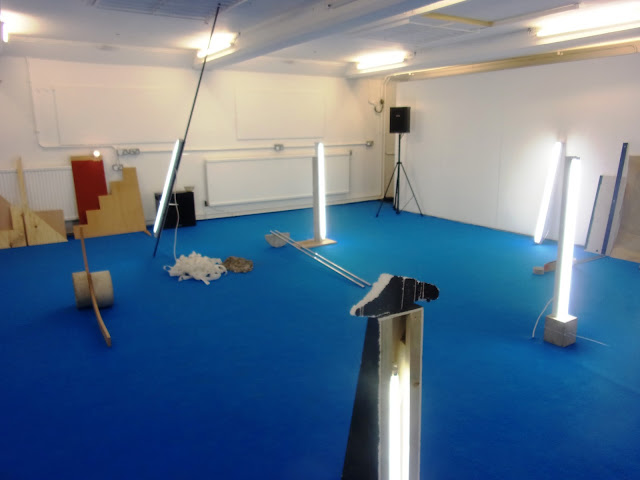 Anne Hardy at fig-2
Anne Hardy at fig-2
___________________
The Shape of Things @ The Dot Project, 94 Fulham Rd – Chelsea

Selma Parlour: Curtain (2013) oil on linen, 60 x 50 cm
You might think, a hundred years on from Malevich, that all the possibilities for geometric abstraction would have been played out. Sure, you can batter it, stick on odd surfaces, play it off against sculpture; complicate the space with mirroring, emphasise the sides of the surface; use surprising shapes of canvas, explore sequences, subtly undermine apparent regularity; or adopt a meta-painting strategy as if you’re depicting geometric paintings, not geometry straight. But those are all moves I’ve seen before. And yet, I haven’t seen them made in the same ways as by this well-chosen quartet of Tim Ellis, Jane , Kritina and Selma Parlour. Turns out you might as well say you’ve seen paintings of people before. True, the hang could be more sympathetic to the subtlety of the work, especially Parlour’s, but it’s good to see this second adventurous show from a new gallery off the usual track.
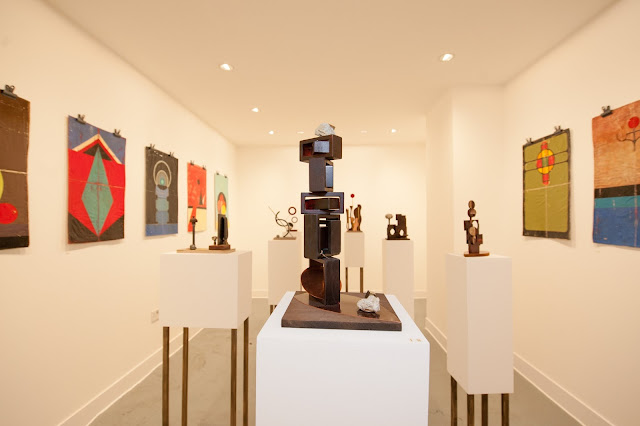
Time Ellis installation shot___________________
Justin Hibbs: Alias_Re_Covered @ Carroll / Fletcher, 56 – 57 Eastcastle St – Fitzrovia
To 12 Sep: www.carrollfletcher.com
 Installation view
Installation view
Justin Hibbs’ first solo show at Carroll / Fletcher is something of a multi-dimensional juggling act. It’s simplest to start with his version of Joseph Albers’ album cover for Mussorgsky’s’Pictures at an Exhibition’. That connects with music and design, and is made with a pin-striping machine on linen, causing glitches which link to the humanising acceptance of errors in even the most computerised of future imaginings. The music cues the show’s ambient soundpiece, and the glitches anticipate the crashed computer screen as a generator of sleek abstractions which set off a dance of two and three dimensions as paintings fold out into sculptures. It’s too complex to describe quickly, but preliminary ideas form a sort of brain in the central room, and some domestically coloured walls offset the industrial aspect of what proves a seamlessly holistic show. Given that Hibbs embraces the fault, I’m tempted to complain, does his show itself have enough?

Alias Re_Versioned, 2015
Emma Bennett: Several Small Fires @ Charlie Smith, 336 Old Street, 2nd Floor – Shoreditch
To 25 July: charliesmithlondon.com
 Haunts, 2015 – oil on oak, 25 x 20 cm
Haunts, 2015 – oil on oak, 25 x 20 cm
It was interesting, at Emma Bennett’s private, view, to hear the wide range of preferred favourites among eleven superficially similar paintings on small oak panels, all showing themes extracted from 18th century paintings on a void-like black ground. Was it all about the painting, especially in the lead motif of fires? Were they meditations on mortality, pushing the vanitas in a contemporary direction flagged by the show’s title (which comes from the late Stuart Croft’s adaptation of Ed Ruscha’s phrase)? Were past and present being played off? Was there a religious dimension? Or was the essence in sex – burning passion, ripe fruit, ruffled bed linen? Just the sort of ambiguity you want.

Painter Marguerite Horner (left), who’s on a campaign to be photographed with artists, looks pleased to have added Emma Bennett to her recent co-starring appearances with Tuymans, Hockney, and Borremans
___________________
Sterling Ruby & Mike Kelley: Spray, Memory @ Inigo Philbrick, 22 Davies St and
Richard Prince: New Portraits @ Gagosian Gallery, 17-19 Davies St – near Bond Street
To 31 July (Philbrick) / 1 Aug (Gagosian)

Mike Kelley: Memory Ware Flat No. 15, 2001 – Plastic and metal buttons and marbles, assorted other plastic and metal objects, sea shells and epoxy resin on wooden panel in wooden artist’s frame 180 x 256 cm
Arguably the two most influential American artists of the ‘baby boomer’ generation have shows either side of Davies Street. Inigo Philbrick’s new space aptly pairs Sterling Ruby’s rethinking of abstract traditions as spray from the streets with ‘memory ware flats’ by Mike Kelley (1954-2012) – encrusted archeological accumulations of everyday objects which act give our collective pasts a decidedly Freudian twist in the context of Kelley’s work as a whole. Opposite, Gagosian shows ‘New Portraits’ by Richard Prince (born 1949): screen captures on canvas lifted from Instagram. They generate something of the bracingly radical ‘can that be art?’ impact of his first rephotographs 40 years ago, and Prince’s account of their genesis is fascinating – make sure ask to see that or pre-read on the gallery site.

Richard Prince: Untitled (portrait), 2015 – Inkjet on canvas, 167 × 124 cm
___________________
Emma Hart & Jonathan Baldock: ‘Suckerz’ @ l’étrangère, 44a Charlotte Rd – Shoreditch
 Emma Hart: Hair ceramics, 2015
Emma Hart: Hair ceramics, 2015
Joanna Mackiewicz-Gemes is doing a good job of maintaining the standards of a space formerly occupied by Carl Freedman and Andrew Mummery, here with an unusual collaboration in which Emma Hart and Jonathan Baldock produce separate work which they combine into a joint installation, at the centre of which is a riotously sensual dinner table replete with tongue napkins, breast plates, drunkenly wonky ceramic wineglasses and cutlery with fingernails. Hart’s spaghetti turned into hair by strategic use of the scrunchy, and Baldock’s animated way with holes in paintings are equally lively. The artists reveal enough empathy of form and approach – both use clay to provide a social context for bodily anxieties – to leave you unsure who’s done what. Like it? Then you’ll want to see Hart II at the Austrian Cultural Forum…
 Installation shot
Installation shot
___________________
Michaël Borremans: Black Mould @ David Zwirner, 24 Grafton St – Mayfair
To 14 Aug: www.davidzwirner.com
 Black Mould / Juggling with Fiery Limbs II, 2015 – oil on wood, 34 x 28 cmJust when you thought the dead good of Guston (Timothy Taylor to 11 June) would overshadow any living painter, up steps Michaël Borremans with a tour de force of dark and sepulchrally presented ritual. Goya, Abu Ghraib, and Japanese theatre meet dance to the implied sound of Black Mold, a chunk of the Jon Spencer Blues Explosion’s alternative rock. Downstairs Pogo is one fifteen part work isolating black-robed figures as a prelude to their full-scale interaction above, where robes are lifted, a severed hand used as a tool and the mood ambiguated by the introduction of a badger, whose song we can only imagine as his score is a blank sheet of paper. Surely it’s not from ‘The Wind in the Willows’?
Black Mould / Juggling with Fiery Limbs II, 2015 – oil on wood, 34 x 28 cmJust when you thought the dead good of Guston (Timothy Taylor to 11 June) would overshadow any living painter, up steps Michaël Borremans with a tour de force of dark and sepulchrally presented ritual. Goya, Abu Ghraib, and Japanese theatre meet dance to the implied sound of Black Mold, a chunk of the Jon Spencer Blues Explosion’s alternative rock. Downstairs Pogo is one fifteen part work isolating black-robed figures as a prelude to their full-scale interaction above, where robes are lifted, a severed hand used as a tool and the mood ambiguated by the introduction of a badger, whose song we can only imagine as his score is a blank sheet of paper. Surely it’s not from ‘The Wind in the Willows’?
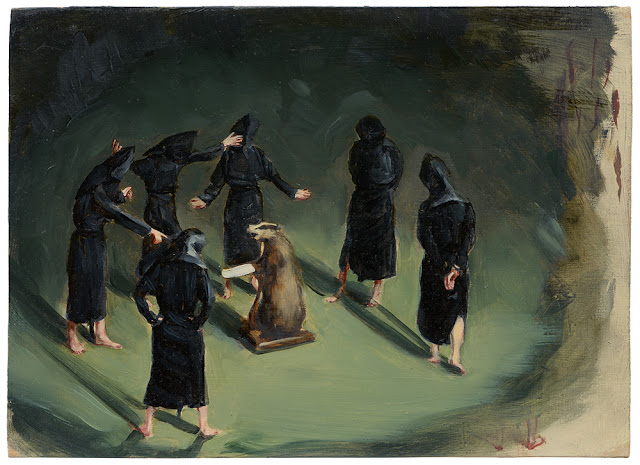 Black Mould / The Badger’s Song, 2015 – oil on wood, 22 x 31 cm
Black Mould / The Badger’s Song, 2015 – oil on wood, 22 x 31 cm
PREVIOUS CHOICES STILL ON
___________________
Günther Förg: ‘To London! A Selection of Paintings’ at Almine Rech, 12 Savile Row; and ‘Lead Paintings’ at White Cube, Mason’s Yard – Central
To 11 July (White Cube) / 25 July (Rech)
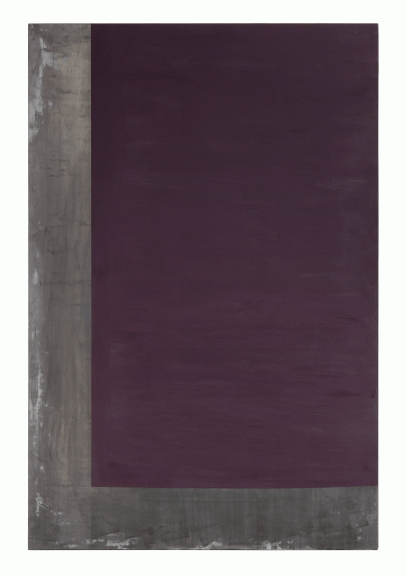 Untitled, 1996 – acrylic on lead laid down on panel 90 x 50 x 3.2 cm
Untitled, 1996 – acrylic on lead laid down on panel 90 x 50 x 3.2 cm
By curious coincidence, given the rarity of his appearances in London, these shows each provide a good introduction to one of the several long-running streams of work produced by the German artist Günther Förg (1952 -2013). Both contain echoes of the architecture – especially windows – which Förg also photographed. White Cube has acrylic paintings on lead sheets wrapped around wooden panels (Förg’s favoured surface in 1984-92). These attain a severe resonance through the scratches, scrapes, and occlusions of their heavy base both in exposed patches and in how glimpses show through and the grounds mutes the colour of the painted sections. Almine Rech presents freely drawn grids, a series which ran from 1992 onwards. In this set from 20o6, the colours are energised by the luminously white grounds, and Förg made a small pendant watercolour version of each afterwards, as if memorialising – by deliberating on – his instinctual actions.
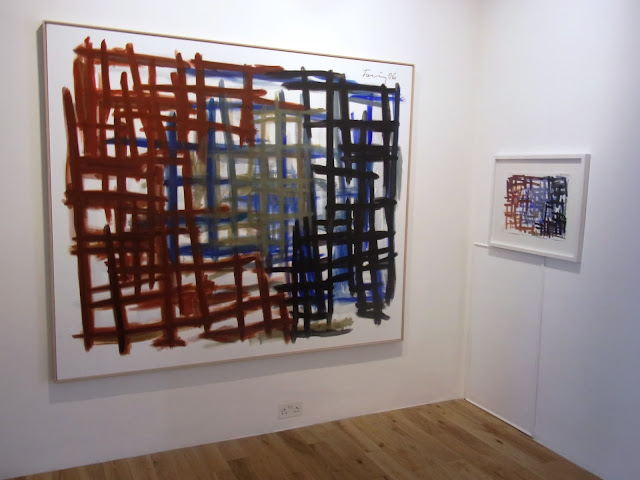 Installation at Almine Rech
Installation at Almine Rech
___________________
St Ives Connections and Dolly Thompsett: The Secret Life & Other Stories @ Art First, 32 Eastcastle St – Fitzrovia
To 14 Aug: www.artfirst.co.uk
 Bryan Wynter: Meander III, 1971-4 – oil on canvas, 111.7 x 141.1 cm
Bryan Wynter: Meander III, 1971-4 – oil on canvas, 111.7 x 141.1 cm
Art First quite often conjures an interesting mix of classic British modernism above more current work in the project space below, and so it is here. A selection by Wilhelmina Barns-Graham and her circle includes large and darkly glowing geometry from her own Outside Inside – Meditation Series, some lively Roger Hilton and a lyrical, indeed summery Bryan Wynter from the very winter of his life (1915-75). Downstairs you’ll find Dolly Thompsett’s latest layerings – material and art historical – of nature charged with desire, often disguising secrets in amongst the intricacy. The surprises for me were small works which allow her characteristic ground of patterned fabric to take over much of the painting; the new still life motif of the pictorially decorated oval serving tray; and her having found a dress so appealingly in tune with her paintings…
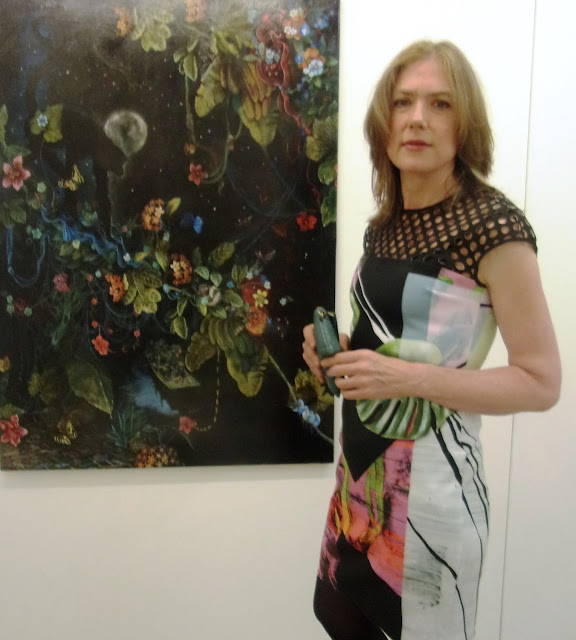 Dolly Thompsett with Huddle, 2014 – oil and mixed media on printed fabric and canvas 131.5 x 95.5cm
Dolly Thompsett with Huddle, 2014 – oil and mixed media on printed fabric and canvas 131.5 x 95.5cm
___________________
Ann Craven: Untitled (Palettes: Naked, Tagged), 2013-14 @ Southard Reid,
7 Royalty Mews – Soho
 Installation view with the tagged palette Untitled (Palette, Cushing, Meadowlark Singing, 10.1.14), 2014
Installation view with the tagged palette Untitled (Palette, Cushing, Meadowlark Singing, 10.1.14), 2014
The spirit of On Kawara lives on in Ann Craven’s paintings: she repeats stock images as much to record time passing as to assert her love of oil paint, wet on wet; and documents the process not just through the painting but by saving her palettes – themselves on canvas – as a means of enabling her to recapture her colours choices. Sometimes she leaves those palettes as is (‘naked’), sometimes she sketches the subject into the paint to‘tag’ them. This show is the first to show only the palettes, itself a naked exposure of her process without the support of the conventional end product. The 50 examples, though, are a riotous triumph of colour and variety. It strikes me that the Serpentine could do worse, now it has two galleries, than to dedicate one each to Craven and her husband, Peter Halley.
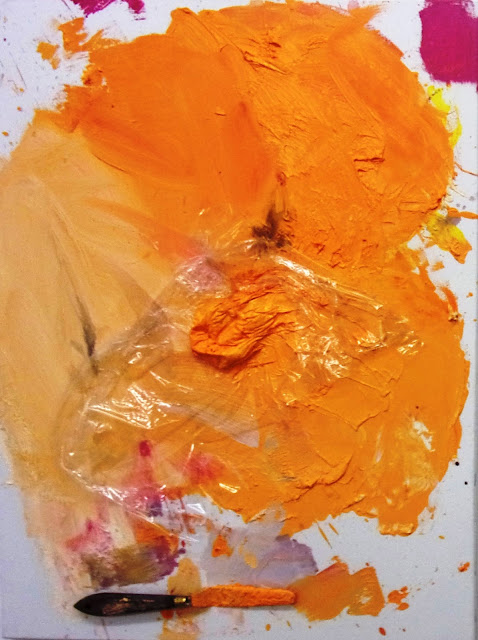 Untitled (Palette, NYC, Moon Halo, Last Night, 11-04-13), 2013 incorporates both knife and plastic applied to keep the paint from drying
Untitled (Palette, NYC, Moon Halo, Last Night, 11-04-13), 2013 incorporates both knife and plastic applied to keep the paint from drying
____________________
Kaari Upson: HOLE @ Massimo De Carlo, 55 South Audley St – Mayfair
 Who’s Afraid of Red, Yellow and Blue, 2014 – Urethane, pigment and aluminium, 217 x 198 x 78 cm
Who’s Afraid of Red, Yellow and Blue, 2014 – Urethane, pigment and aluminium, 217 x 198 x 78 cm
Kaari Upson has made her name through the long-running psychological intensity of attempting to inhabit another in ‘The Larry Project’ (2007-14). Facing the challenge of moving on, she’s conjured sculptures which operate very independently yet retain a psychological charge. Upson’s own cut-and-paste thesaurus-style list of ‘hole’ terms sets the mood. On the ground floor, sofas are cast repeatedly, and hard, onto the walls. They’re like interior organs, and also fleshy lips – a resemblance reinforced when you descend to find Angelina Jolie’s mouth as paintings and wallpaper, and urethane forms partially cast from wood which stand at Jolie’s height. Each has three holes one takes to be hers, and somehow merges body, tree and mattress.
 Lower Floor Room III Installation view
Lower Floor Room III Installation view
Ben Woodeson: obstacle @ BERLONI, 63 Margaret St – Fitzrovia
To 1 Aug: www.berlonigallery.com
 Point Taken, 2015 – found table and sheet glass
Point Taken, 2015 – found table and sheet glass
Here Ben Woodeson kicks rather refreshingly through health and safety concerns: panes of glass are left to bend where you can walk into them; rat traps look set to snap shut and shatter an intricate network of neon; 99 billiard balls are held up just by a glass rod which could easily be kicked away; and shiny floor plates in tribute to Carl Andre prove ‘hot’ in that they are electrified – you can and should generate a satisfying crackle by spreading your fingers across two plates. Nor is this mere shock art: Woodeson’s explorations of how to make materials behave dangerously also carry an aesthetic charge.
 I love you, I want you, I need you… (Hot for Carl), 2015: sheet brass, glass and electric fence power supply
I love you, I want you, I need you… (Hot for Carl), 2015: sheet brass, glass and electric fence power supply
Et Mon Droit @ Copperfield Gallery, 6 Copperfield Street – Borough / Southwark
to 11 July: www.copperfieldgallery.com
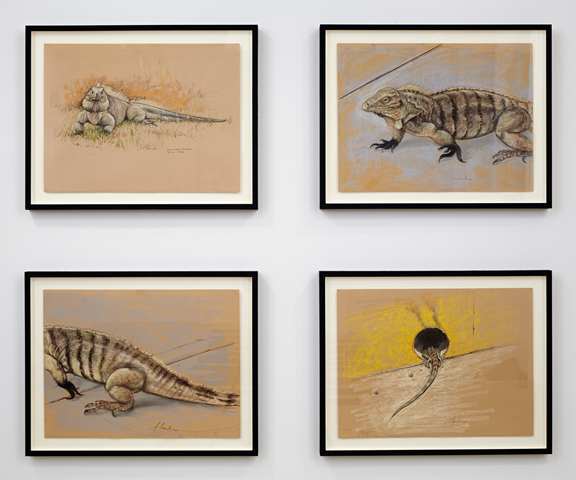 David Birkin, Cyclura Nubila (2014), Comissioned Sketches by courtroom artist Janet Hamlin, 19×25″ legal paper
David Birkin, Cyclura Nubila (2014), Comissioned Sketches by courtroom artist Janet Hamlin, 19×25″ legal paper
I guess you won’t be surprised to learn that a show about art and the law is full of paradox: Marco Godoy reminds us that we cannot own currency, we merely borrow it, hence his effacement of coins is illegal; on the other hand, Jason File photocopies a Dan Flavin certificate then remakes it by hand to yield a fake of a fake which – unlike Flavin’s original certificate – he designates as art; and David Birkin hires a court artist to put Guantánamo Bay’s iguanas in the dock, so pointing up their seeming to have more rights than people. Add the more familiar conceptual twists of Etienne Chambaud, Jill Magid and Carey Young (whoseObsidian Contract may be best viewed while naked) and you have an exhibition which – if there’s any justice – should be a success.
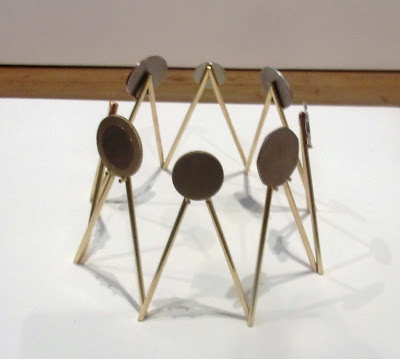 Marco Godoy, Who Makes Europe (2013), altered coins and armature
Marco Godoy, Who Makes Europe (2013), altered coins and armature
Herbert Golser: A Quivering Solidity @ rosenfeld porcini, 37 Rathbone Street – Fitzrovia
 Untitled, 2014 / 15 – pear wood
Untitled, 2014 / 15 – pear wood
Ignore that over-insistent show title: Austrian sculptor Herbert Golser has a remarkable repertoire of cuts, changing the form of wood through the virtuosic use of a various saws. Choosing mostly pear, which allies an attractive golden tinge to a twisting upthrust, he works iteratively to interpret the tree’s inner energy rather than impose himself on it. Golser’s interventions take months to stabilise, and often leave the wood looking fragile – but you can still sense the strength of the trees, and I love how some forms seem to echo the natural arboreal processes of forming rings, or hosting fungi or hives.
The show’s curator, Rita GT, has designed her clothes from Francisco Vidal’s paintings
Francisco Vidal with one of his portrait drawings. I should add that they’re not meant to be realistic…
 Verdite Forest Head, 2015Verdite 23 x 23 x 20 cm
Verdite Forest Head, 2015Verdite 23 x 23 x 20 cm Lone Deer, Sanderbands, Bangldesh, 2008The London-based Japanese Tomoko Yaneda shows images from 2003 onwards to deal with the not infrequent trope of apparently innocuous photographs which turn out to be of sites freighted with historical and emotional resonance: a means, if you will, of magnifying the innate memorialising tendency of photography* . Among Yoneda’s subjects are homes built in the capital of Taiwan during a period of Japanese occupation (1895 to 1945); the most frequently flooded Delta in Bangladesh; and Stalin City in Hungary. Apart from being somewhat ahead of that curve, what distinguishes her treatment is the sheer poised allure of her pictures, which quietly raises the impact of the contradictions involved, and her ability to fix on some what TS Eliot might have called an objective correlative for the emotions felt, from a lone deer to peeling walls to a semi-submerged couple.
Lone Deer, Sanderbands, Bangldesh, 2008The London-based Japanese Tomoko Yaneda shows images from 2003 onwards to deal with the not infrequent trope of apparently innocuous photographs which turn out to be of sites freighted with historical and emotional resonance: a means, if you will, of magnifying the innate memorialising tendency of photography* . Among Yoneda’s subjects are homes built in the capital of Taiwan during a period of Japanese occupation (1895 to 1945); the most frequently flooded Delta in Bangladesh; and Stalin City in Hungary. Apart from being somewhat ahead of that curve, what distinguishes her treatment is the sheer poised allure of her pictures, which quietly raises the impact of the contradictions involved, and her ability to fix on some what TS Eliot might have called an objective correlative for the emotions felt, from a lone deer to peeling walls to a semi-submerged couple.  Isa Genzken, Basic Research, 1989, oil on canvas, 90 x 75 cm. Courtesy the artist and Galerie Buchholz, Berlin/Cologne
Isa Genzken, Basic Research, 1989, oil on canvas, 90 x 75 cm. Courtesy the artist and Galerie Buchholz, Berlin/Cologne Time Ellis installation shot___________________
Time Ellis installation shot___________________
 Alias Re_Versioned, 2015
Alias Re_Versioned, 2015 Haunts, 2015 – oil on oak, 25 x 20 cm
Haunts, 2015 – oil on oak, 25 x 20 cm

 Emma Hart: Hair ceramics, 2015
Emma Hart: Hair ceramics, 2015 Black Mould / Juggling with Fiery Limbs II, 2015 – oil on wood, 34 x 28 cmJust when you thought the dead good of Guston (Timothy Taylor to 11 June) would overshadow any living painter, up steps Michaël Borremans with a tour de force of dark and sepulchrally presented ritual. Goya, Abu Ghraib, and Japanese theatre meet dance to the implied sound of Black Mold, a chunk of the Jon Spencer Blues Explosion’s alternative rock. Downstairs Pogo is one fifteen part work isolating black-robed figures as a prelude to their full-scale interaction above, where robes are lifted, a severed hand used as a tool and the mood ambiguated by the introduction of a badger, whose song we can only imagine as his score is a blank sheet of paper. Surely it’s not from ‘The Wind in the Willows’?
Black Mould / Juggling with Fiery Limbs II, 2015 – oil on wood, 34 x 28 cmJust when you thought the dead good of Guston (Timothy Taylor to 11 June) would overshadow any living painter, up steps Michaël Borremans with a tour de force of dark and sepulchrally presented ritual. Goya, Abu Ghraib, and Japanese theatre meet dance to the implied sound of Black Mold, a chunk of the Jon Spencer Blues Explosion’s alternative rock. Downstairs Pogo is one fifteen part work isolating black-robed figures as a prelude to their full-scale interaction above, where robes are lifted, a severed hand used as a tool and the mood ambiguated by the introduction of a badger, whose song we can only imagine as his score is a blank sheet of paper. Surely it’s not from ‘The Wind in the Willows’? Black Mould / The Badger’s Song, 2015 – oil on wood, 22 x 31 cm
Black Mould / The Badger’s Song, 2015 – oil on wood, 22 x 31 cm Untitled, 1996 – acrylic on lead laid down on panel 90 x 50 x 3.2 cm
Untitled, 1996 – acrylic on lead laid down on panel 90 x 50 x 3.2 cm Bryan Wynter: Meander III, 1971-4 – oil on canvas, 111.7 x 141.1 cm
Bryan Wynter: Meander III, 1971-4 – oil on canvas, 111.7 x 141.1 cm Dolly Thompsett with Huddle, 2014 – oil and mixed media on printed fabric and canvas 131.5 x 95.5cm
Dolly Thompsett with Huddle, 2014 – oil and mixed media on printed fabric and canvas 131.5 x 95.5cm Installation view with the tagged palette Untitled (Palette, Cushing, Meadowlark Singing, 10.1.14), 2014
Installation view with the tagged palette Untitled (Palette, Cushing, Meadowlark Singing, 10.1.14), 2014Untitled (Palette, NYC, Moon Halo, Last Night, 11-04-13), 2013 incorporates both knife and plastic applied to keep the paint from drying
 Who’s Afraid of Red, Yellow and Blue, 2014 – Urethane, pigment and aluminium, 217 x 198 x 78 cm
Who’s Afraid of Red, Yellow and Blue, 2014 – Urethane, pigment and aluminium, 217 x 198 x 78 cm Lower Floor Room III Installation view
Lower Floor Room III Installation view Point Taken, 2015 – found table and sheet glass
Point Taken, 2015 – found table and sheet glass I love you, I want you, I need you… (Hot for Carl), 2015: sheet brass, glass and electric fence power supply
I love you, I want you, I need you… (Hot for Carl), 2015: sheet brass, glass and electric fence power supply David Birkin, Cyclura Nubila (2014), Comissioned Sketches by courtroom artist Janet Hamlin, 19×25″ legal paper
David Birkin, Cyclura Nubila (2014), Comissioned Sketches by courtroom artist Janet Hamlin, 19×25″ legal paperMarco Godoy, Who Makes Europe (2013), altered coins and armature
Untitled, 2014 / 15 – pear wood
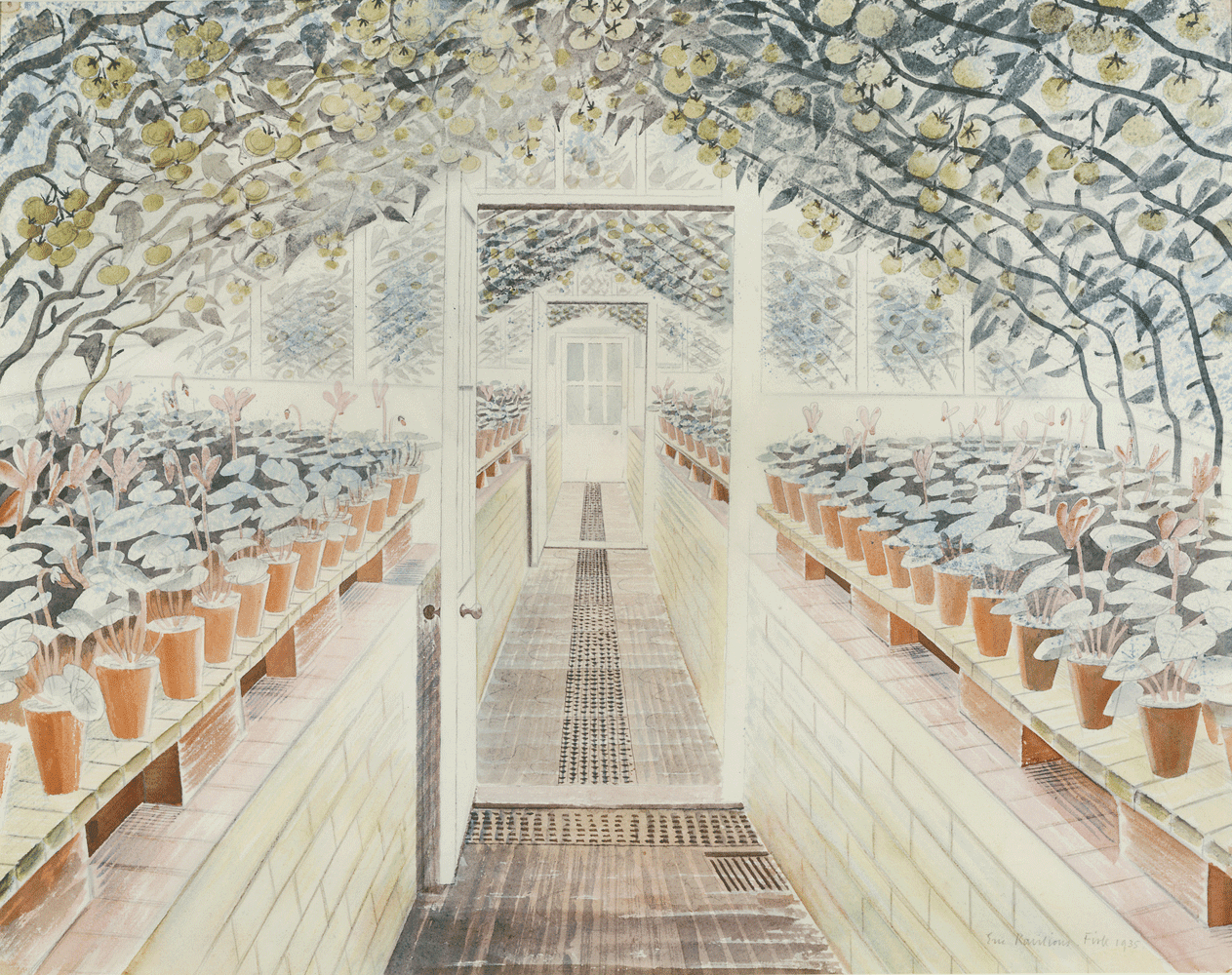 The Greenhouse, cyclamen and tomatoes, 1935
The Greenhouse, cyclamen and tomatoes, 1935
